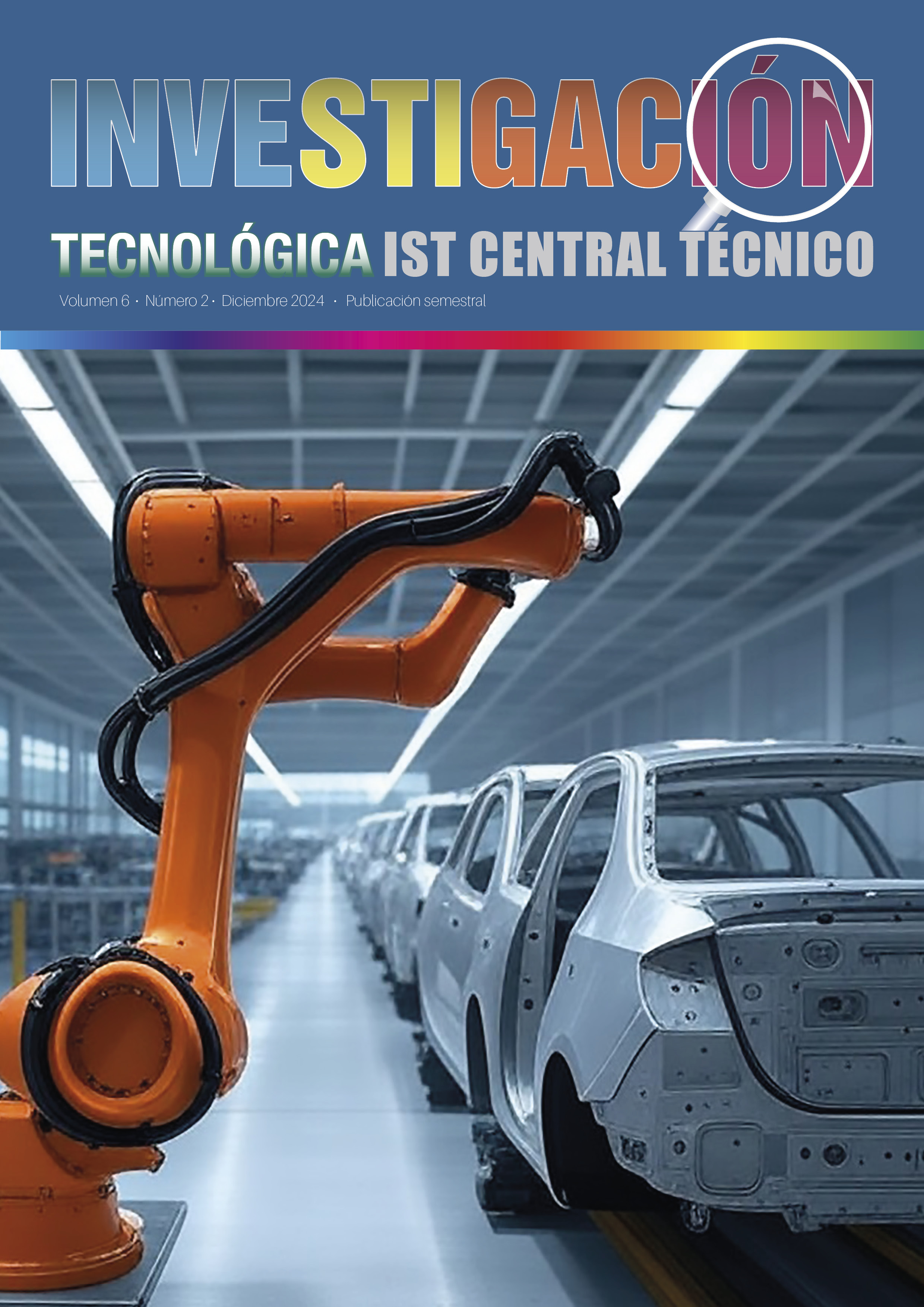EL Development of Electromobility in Ecuador: Challenges and Perspectives in the Adoption of Hybrid Vehicles
Desarrollo de la Electromovilidad en Ecuador: Retos y Perspectivas en la Adopción de Vehículos Híbridos
DOI:
https://doi.org/10.70998/itistct.v6i2.175Keywords:
Análisis; Batería; Vehículo híbrido; Litio; SodioAbstract
In this research work, the growing demand for the sale of hybrid propulsion vehicles, their typology, and different configurations is addressed. Additionally, through literature reviews, it details the most common failures reported in vehicles that incorporate this type of propulsion, which continues to increase, considering the tax benefits and the gradual reduction in prices due to various trade agreements, as well as the decrease in pollutant emissions they provide. Furthermore, different battery technologies are reviewed, concluding that this type of technology is gaining ground and becoming increasingly affordable. At the same time, despite the difficulties that may arise in these vehicles, primarily in battery damage and the cost of replacement, several manufacturers have positioned configurations with mild hybridization as preferred options for Ecuadorian consumers.
References
Alejandro García, Juan Reyes. (2013). Patentamiento, trayectoria y características de las baterias automotrices: El caso de los autos híbridos | Entreciencias: Diálogos en la Sociedad del Conocimiento. http://revistas.unam.mx/index.php/entreciencias/article/view/62074
ANFAC | Notas de matriculación. (2021, noviembre 30). https://anfac.com/category/actualidad/notas-de-matriculacion/
Benajes, J., García, A., Monsalve-Serrano, J., & Martínez-Boggio, S. (2019). Optimization of the parallel and mild hybrid vehicle platforms operating under conventional and advanced combustion modes. Energy Conversion and Management, 190, 73-90. https://doi.org/10.1016/j.enconman.2019.04.010
Chan, C. C. (2007). The State of the Art of Electric, Hybrid, and Fuel Cell Vehicles. Proceedings of the IEEE, 95(4), 704-718. https://doi.org/10.1109/JPROC.2007.892489
Chele Sancan, D. G. (2017). Vehículos híbridos, una solución interina para bajar los niveles de contaminación del medio ambiente causados por las emisiones provenientes de los motores de combustión interna. INNOVA Research Journal, 2(12), 1-10.
¿Cuál es el promedio de kilometraje y vida útil de un Toyota Prius? (2017, julio 21). Puro Motores. https://www.puromotores.com/13154719/cual-es-el-promedio-de-kilometraje-y-vida-util-de-un-toyota-prius
Huaman Cochachin, J. N., & Muñoz Astuquipan, J. P. (2020). Impacto financiero de la renovación del parque automotor con autos híbridos en las empresas importadoras del sector automotriz en Lima Metropolitana, 2019. Universidad Peruana de Ciencias Aplicadas (UPC). https://doi.org/10.19083/tesis/652704
Iberisa. (2018, septiembre 17). ¿Se pueden reparar las baterías híbridas? https://iberisasl.com/blog/reparar-las-baterias-hibridas/
Instituto de Investigación Geológico y Energético. (2019, enero 31). Consumo eléctrico por habitante continúa creciendo en Ecuador – Instituto de Investigación Geológico y Energético. https://www.geoenergia.gob.ec/consumo-electrico-por-habitante-continua-creciendo-en-ecuador/
Jeréz Daniela. (2018, agosto 6). Análisis del proceso de recuperación de la batería de alta tensión del vehículo Toyota Highlander Híbrido | INNOVA Research Journal. 1, 1(1), 10.
Leonidas Quiroz Erazo, Jhonatan Aguilar Santamaría, Cristhian Rumiguano Jiménez, & Germán Erazo Laverde. (2028). Influencia del sistema start-stop en el vehículo respecto durabilidad de la batería de acumuladores. 4.
Menchaca, Hilda. (2023). Desempeño de un vehículo híbrido y su contraparte de combustión interna bajo condiciones de manejo de una ciudad mexicana. 29(2), 219-230.
Pérez Sepa, M. A., Angueta Ponce, A. V., Guasumba Maila, J. E., & Calero Torres, D. A. (2022). Estimación de la vida útil de las baterías de los vehículos híbridos causas y consecuencias. Dominio de las Ciencias, 8(2), 770-781.
Primicias. (2024a, febrero 23). Así caerán los precios de los carros chinos con el acuerdo comercial. Primicias. https://www.primicias.ec/noticias/economia/carros-chinos-desgravacion-acuerdo-comercial/
Primicias. (2024b, octubre 15). Carros híbridos y eléctricos ya son el 13% de las ventas en Ecuador, ¿Cuáles son los más vendidos y cuánto cuestan? Primicias. https://www.primicias.ec/economia/carros-hibridos-electricos-ventas-modelos-precios-81130/
Use of energy in explained—U.S. Energy Information Administration (EIA). (2021, mayo 14). https://www.eia.gov/energyexplained/use-of-energy/

Downloads
Published
How to Cite
Issue
Section
License
Copyright (c) 2024 JOSÉ BELTRÁN

This work is licensed under a Creative Commons Attribution-NonCommercial 4.0 International License.
COPYRIGHT
The ISTCT Technological Research journal is an Open Access publication, whose contents are disseminated under a Creative Commons Attribution-Non-Commercial license (CC-BY NC 4.0 International). All articles published in the ISTCT Technological Research journal are published in Open Access and are available online for free immediately after publication.
This journal provides metadata for third-party indexing services through the open files initiative.
The ISTCT Technological Research journal recognizes and respects the moral rights of the authors, as well as the ownership of the patrimonial right, which will be transferred non-exclusively to the journal to allow its legal dissemination in Open Access.
The ISTCT Technological Research journal does not reserve the rights to publish articles. Authors may distribute their own material in any other medium or medium, as long as it is for non-commercial purposes, informing the editors that the work will be published again and giving the corresponding credit to the ISTCT Technological Research journal.
Authors can make other independent and additional contractual agreements for the distribution of the article published in this journal (e.g., include it in an institutional repository or publish it in a book) as long as they clearly indicate that the work was published for the first time in "ISTCT Technological Research Magazine". In the case of reproduction, a note similar to the following must be included:
"This text was originally published in REVISTA DE INVESTIGACIÓN TECNOLÓGICA ISTCT N ° -, section -----, number of pages, year of publication."
Authors are recommended to publish their work on the Internet (for example on institutional or personal pages) in the final version published by REVISTA DE INVESTIGACIÓN TECNOLÓGICA ISTCT, as it may lead to a greater and faster dissemination of the published work (see The Effect of Open Access).
The publications in this magazine, due to their free nature, do not entitle the authors to any financial remuneration.


